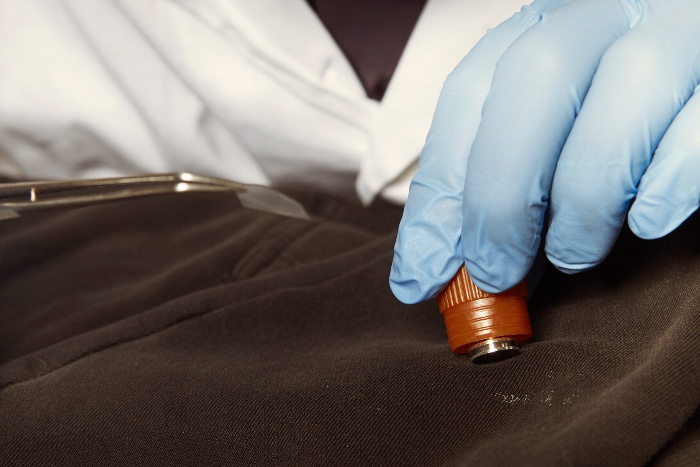Tarah Helsel 9 min read
GSR Frequently Asked Questions
Contributors
Tarah Helsel
Subscribe to our newsletter
Gunshot residue (GSR) testing is a complex forensic technique that is often misunderstood. To help clarify the facts and dispel common misconceptions, we have compiled a comprehensive list of frequently asked questions about GSR analysis. By addressing these inquiries, we aim to provide a better understanding of what GSR testing can and cannot reveal. Let's dive into the intricacies of this forensic science to shed light on the truth behind the particles left behind by a discharged firearm.
Q: Is gunshot residue the same as gunpowder?
A: Gunshot residue and gunpowder are related but distinct terms. Gunpowder is the explosive substance used to propel a bullet, while gunshot residue refers to all particles that result from a firearm discharge and can contain a combination of primer residue and gunpowder residue among other components. The “gunshot residue” testing that RJ Lee Group provides is strictly for primer gunshot residue, which comes from the inorganic material that is contained in the primer of a cartridge.
Q: What is the best way to collect GSR samples?
A: Scanning electron microscopy (SEM) kits that utilize adhesive stubs are the recommended method of GSR collection and should be used whenever possible. These stubs can be easily used to collect from hands, clothing, vehicles, or other areas of interest.
Q: Can a (SEM) GSR kit collected a number of years ago go “bad”?
A: No, once a kit containing SEM stubs is collected and stored as evidence, the collected particulate will not disappear, disintegrate, go bad, etc. The analysis on a 10 year old kit will show the same results as if the kit were analyzed immediately after collection. Primer GSR is made of metals, so it does not degrade over time.

Q: How long after a shooting incident can GSR samples still be collected?
A: This is dependent on the activity that goes on in this time span. We do not have a time limit that we will not analyze samples after, but we do ask that you be aware of the factors that contribute to particle loss, as these could cause a negative result even if someone discharged a firearm. The more time that passes between an incident and sample collection, the more opportunity there is for activities to occur that could disrupt or remove particles.
Q: How can particles be lost?
A: The following can cause particles to be removed: environmental conditions including wind and rain. Movement and activity of a subject such as running, washing of the hands, putting hands in pockets. Laundering of items of clothing, shaking of items of clothing, etc.
Q: What other sources produce particles similar to GSR?
A: Both fireworks and brake pads can produce particles with lead, barium and/or antimony. However, samples taken from fireworks will show high amounts of magnesium and samples taken from brake pads will show high amounts of iron. Furthermore, the use of lead was discontinued in brake pads in the 2000’s. During analysis, the entire populations of particulate are taken into consideration when analyzing for GSR.
Q: Are you able to tell what firearm particles came from?
A: No, individual firearms do not have specific tangents. A particle characteristic of GSR is only indicative of the discharge of a firearm, not the discharge of a specific firearm.
Q: Are you able to tell how long particles have been present on a surface?
A: No, there are no indicators to how long particles have been present. If an item of clothing containing GSR is left undisturbed for 5 years, the GSR will be the same as the day it was deposited. We can tell you whether or not GSR is on an item, we cannot say how or when it got there.

Q: If someone has GSR on them does that mean they discharged a firearm?
A: No, the presence of GSR on a person can be explained by three possibilities:
- The person discharged a firearm
- The person was in close proximity to a discharging firearm
- The person came into contact with something that contained GSR
These scenarios are equally probable, and the likelihood of one over the others cannot be determined through GSR analysis.
Q: Does the lack of GSR mean someone did not discharge a firearm?
A: No. GSR particles are easily removed, so it is impossible to say for certain that a lack of GSR particles means that a person did not fire a weapon, as it is also possible that someone could have discharged a firearm but removed the particles prior to the time of collection.
Q: Does the average person have particles related to the discharge of a firearm on them?
A: No, unless that person is part of a profession or hobby where particles similar to GSR would be present.
Q: What is the difference between primer residue and powder residue?
A: Primer residue is what is referred to when speaking generally of GSR, it is the mixture of lead, barium and antimony that originates in the primer cap of a cartridge. It is also sometimes referred to as inorganic GSR, primer residue, or pGSR.
Powder residue refers to the particulate produced by the gun powder in a cartridge. This particulate with be nitrogen based as gun powder is typically made up of nitroglycerin and nitrocellulose. It is also sometimes referred to as organic GSR.

By comprehending the nature of GSR and its interaction with individuals and surfaces, we enhance our insight into the capabilities of GSR analysis and the sophisticated analytical methods employed by scientists to unveil concealed realities.
RJ Lee Group’s forensic scientists routinely perform GSR analysis on samples from skin, clothing, vehicles, and other surfaces. We offer exceptional turnaround times and we pioneered the use of computer-controlled scanning electron microscopy to quickly and accurately identify GSR particles.



